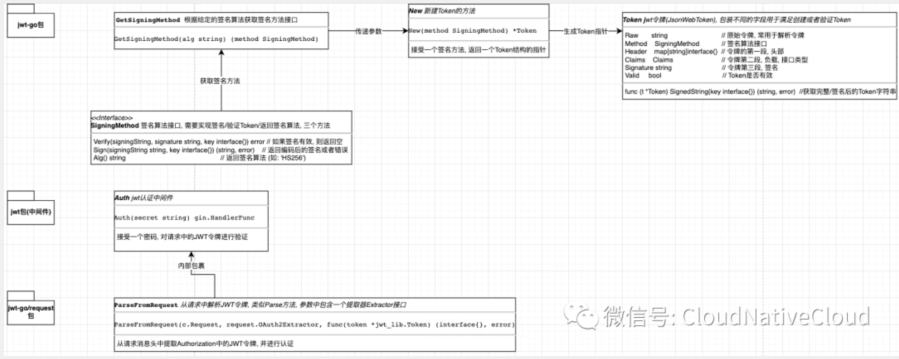什么是JWT?
JSON Web Token(缩写 JWT)是目前最流行的跨域认证解决方案,也是目前前后端分离项目中普遍使用的认证技术. 本文介绍如何在Golang Gin Web框架中使用JWT认证中间件以及模拟测试, 以供参考, 关于JWT详细原理可以参考:
- JWT RFC: https://tools.ietf.org/html/rfc7519
- JWT IETF: http://self-issued.info/docs/draft-ietf-oauth-json-web-token.html
- JSON Web Token入门教程: http://www.ruanyifeng.com/blog/2018/07/json_web_token-tutorial.html
主要流程
- 初始化Gin引擎
- 定义获取Token的接口, 访问该接口, 内部自动生成JWT令牌, 并返回给前端
- 定义需要认证的路由接口, 使用JWT中间件进行认证, 中间件由
- 利用GoConvey(Golang的测试框架,集成go test, 支持终端和浏览器模式), 构造客户端, 填写Token, 模拟前端访问
- JWT中间件进行认证, 认证通过则返回消息体, 否则直接返回401或其他错误
流程图

该流程图描述了服务端代码中的Token构造, 以及认证流程.
服务端代码
main.go中填充以下代码, 运行go run main.go, 开启Web服务.
package main
import (
jwt_lib "github.com/dgrijalva/jwt-go"
"github.com/dgrijalva/jwt-go/request"
"github.com/gin-gonic/gin"
"log"
"time"
)
var (
mysupersecretpassword = "unicornsAreAwesome"
)
func Auth(secret string) gin.HandlerFunc {
return func(c *gin.Context) {
//log.Printf("Request:\n%+v", c.Request)
// ParseFromRequest方法提取路径请求中的JWT令牌, 并进行验证
token, err := request.ParseFromRequest(c.Request, request.OAuth2Extractor, func(token *jwt_lib.Token) (interface{}, error) {
b := ([]byte(secret))
//log.Printf("b:%+v", b)
return b, nil
})
log.Printf("token:%+v", token)
if err != nil {
c.AbortWithError(401, err)
}
}
}
func main() {
r := gin.Default()
public := r.Group("/api")
// 定义根路由, 访问http://locahost:8080/api/可以获取到token
public.GET("/", func(c *gin.Context) {
// Create the token New方法接受一个签名方法的接口类型(SigningMethod)参数, 返回一个Token结构指针
// GetSigningMethod(签名算法algorithm)
token := jwt_lib.New(jwt_lib.GetSigningMethod("HS256")) //默认是签名算法是HMAC SHA256(写成 HS256)
log.Printf("token:%+v", token)
//2020/12/10 22:32:02 token:&{Raw: Method:0xc00000e2a0 Header:map[alg:HS256 typ:JWT] Claims:map[] Signature: Valid:false}
// Set some claims 设置Id和过期时间字段, MapClaims实现了Clainms接口
token.Claims = jwt_lib.MapClaims{
"Id": "Christopher",
"exp": time.Now().Add(time.Hour * 1).Unix(),
}
// Sign and get the complete encoded token as a string // 签名并得到完整编码后的Token字符串
tokenString, err := token.SignedString([]byte(mysupersecretpassword))
//{"token":"eyJhbGciOiJIUzI1NiIsInR5cCI6IkpXVCJ9.eyJJZCI6IkNocmlzdG9waGVyIiwiZXhwIjoxNjA3NjE0MzIyfQ.eQd7ztDn3706GrpitgnikKgOtzx-RHnq7cr2eqUlsZo"}
if err != nil {
c.JSON(500, gin.H{"message": "Could not generate token"})
}
c.JSON(200, gin.H{"token": tokenString})
})
// 定义需要Token验证通过才能访问的私有接口组http://localhost:8080/api/private
private := r.Group("/api/private")
private.Use(Auth(mysupersecretpassword)) // 使用JWT认证中间件(带参数)
/*
Set this header in your request to get here.
Authorization: Bearer `token`
*/
// 定义具体的私有根接口:http://localhost:8080/api/private/
private.GET("/", func(c *gin.Context) {
c.JSON(200, gin.H{"message": "Hello from private"})
})
r.Run("localhost:8080")
}
- 1.
- 2.
- 3.
- 4.
- 5.
- 6.
- 7.
- 8.
- 9.
- 10.
- 11.
- 12.
- 13.
- 14.
- 15.
- 16.
- 17.
- 18.
- 19.
- 20.
- 21.
- 22.
- 23.
- 24.
- 25.
- 26.
- 27.
- 28.
- 29.
- 30.
- 31.
- 32.
- 33.
- 34.
- 35.
- 36.
- 37.
- 38.
- 39.
- 40.
- 41.
- 42.
- 43.
- 44.
- 45.
- 46.
- 47.
- 48.
- 49.
- 50.
- 51.
- 52.
- 53.
- 54.
- 55.
- 56.
- 57.
- 58.
- 59.
- 60.
- 61.
- 62.
- 63.
- 64.
- 65.
- 66.
- 67.
- 68.
- 69.
- 70.
- 71.
- 72.
- 73.
- 74.
客户端代码
新建jwt_test.go文件, 填充以下代码, 运行go test执行单元测试.
package test_test
import (
"encoding/json"
. "github.com/smartystreets/goconvey/convey" //https://github.com/smartystreets/goconvey GoConvey是Golang的测试框架,集成go test, 支持终端和浏览器模式.
"io/ioutil"
"log"
"net/http"
"strings"
"testing"
)
type User struct {
Username string `json:"username"`
Password string `json:"password"`
}
type Response struct {
Token string `json:"token"`
}
func createNewsUser(username, password string) *User {
return &User{username, password}
}
func TestLogin(t *testing.T) {
Convey("Should be able to login", t, func() {
user := createNewsUser("jonas", "1234")
jsondata, _ := json.Marshal(user)
userData := strings.NewReader(string(jsondata))
log.Printf("userData:%+v", userData)
// 这里模拟用户登录, 实际上后台没有使用用户名和密码, 该接口直接返回内部生成的Token
req, _ := http.NewRequest("GET", "http://localhost:8080/api/", userData)
req.Header.Set("Content-Type", "application/json")
client := &http.Client{}
res, _ := client.Do(req)
//log.Printf("res:%+v", res)
So(res.StatusCode, ShouldEqual, 200) //对响应码进行断言, 期望得到状态码为200
Convey("Should be able to parse body", func() { //解析响应体
body, err := ioutil.ReadAll(res.Body)
defer res.Body.Close()
So(err, ShouldBeNil)
Convey("Should be able to get json back", func() {
responseData := new(Response)
err := json.Unmarshal(body, responseData)
So(err, ShouldBeNil)
log.Printf("responseData:%s", responseData)
Convey("Should be able to be authorized", func() {
token := responseData.Token //提取Token
log.Printf("token:%s", token)
// 构造带Token的请求
req, _ := http.NewRequest("GET", "http://localhost:8080/api/private", nil)
req.Header.Set("Authorization", "Bearer "+token) //设置认证头
client = &http.Client{}
res, _ := client.Do(req)
body, err := ioutil.ReadAll(res.Body)
if err != nil {
log.Printf("Read body failed, %s", err.Error())
}
log.Printf("Body:%s", string(body))
So(res.StatusCode, ShouldEqual, 200)
})
})
})
})
}
- 1.
- 2.
- 3.
- 4.
- 5.
- 6.
- 7.
- 8.
- 9.
- 10.
- 11.
- 12.
- 13.
- 14.
- 15.
- 16.
- 17.
- 18.
- 19.
- 20.
- 21.
- 22.
- 23.
- 24.
- 25.
- 26.
- 27.
- 28.
- 29.
- 30.
- 31.
- 32.
- 33.
- 34.
- 35.
- 36.
- 37.
- 38.
- 39.
- 40.
- 41.
- 42.
- 43.
- 44.
- 45.
- 46.
- 47.
- 48.
- 49.
- 50.
- 51.
- 52.
- 53.
- 54.
- 55.
- 56.
- 57.
- 58.
- 59.
- 60.
- 61.
- 62.
- 63.
- 64.
- 65.
- 66.
- 67.
参考文档
gin-gonic/contrib/jwt中间件: https://github.com/gin-gonic/contrib/tree/master/jwt







































